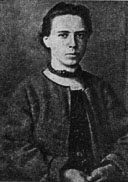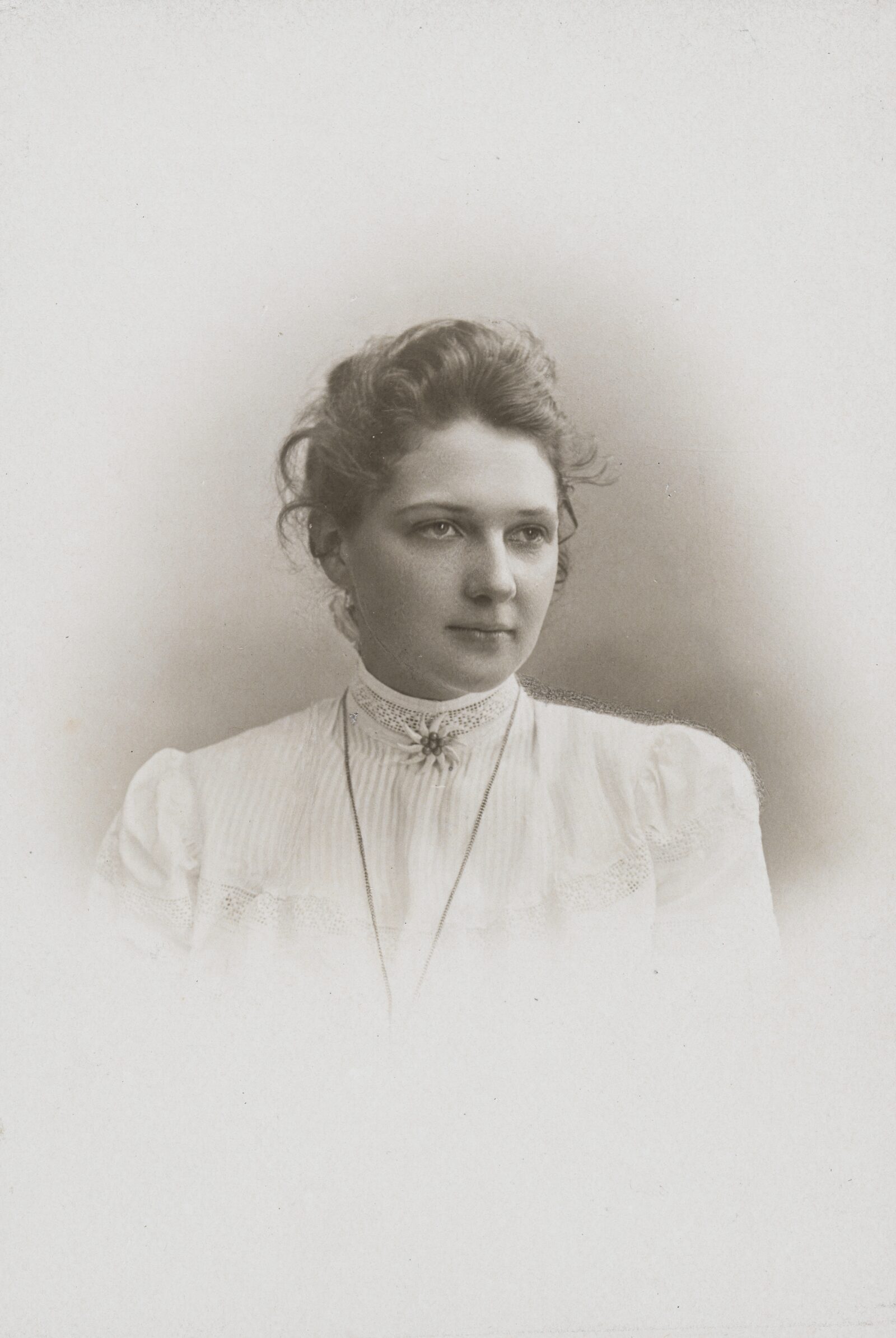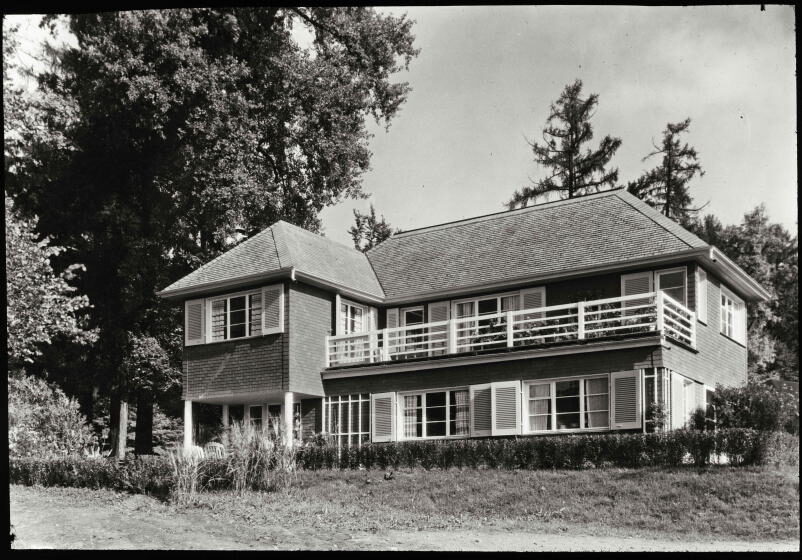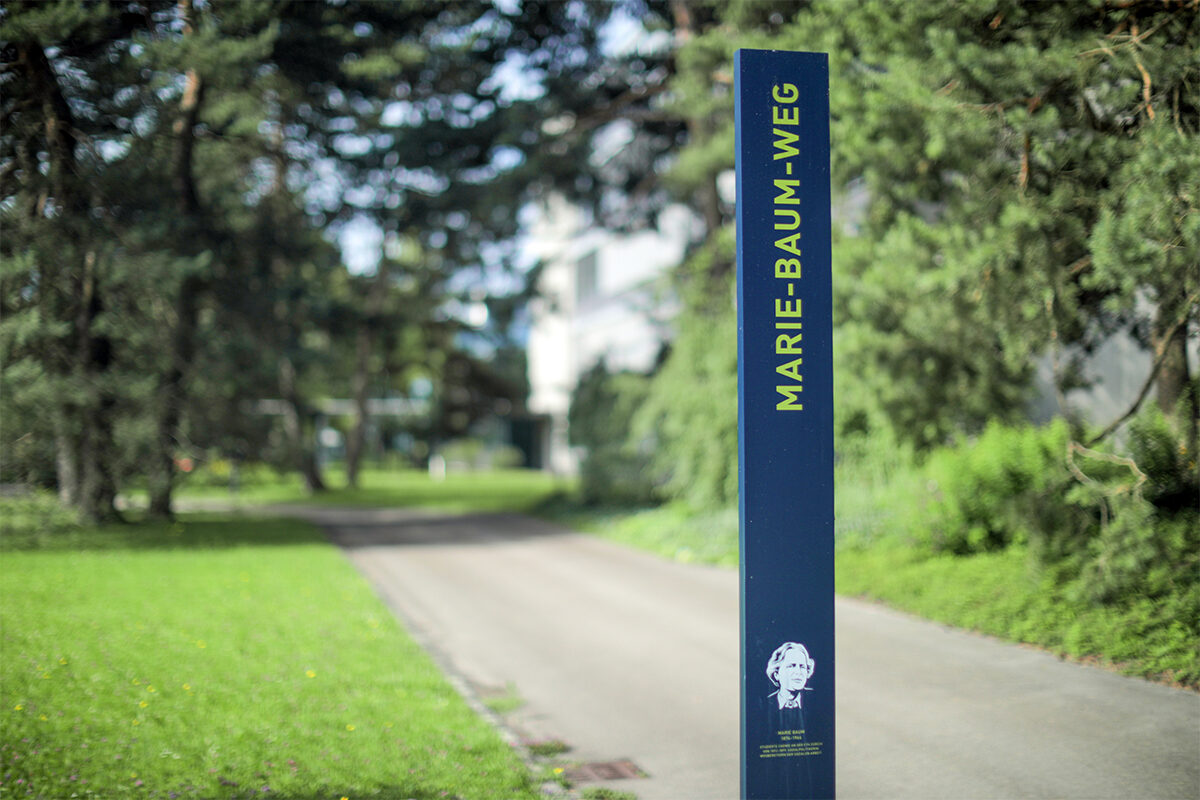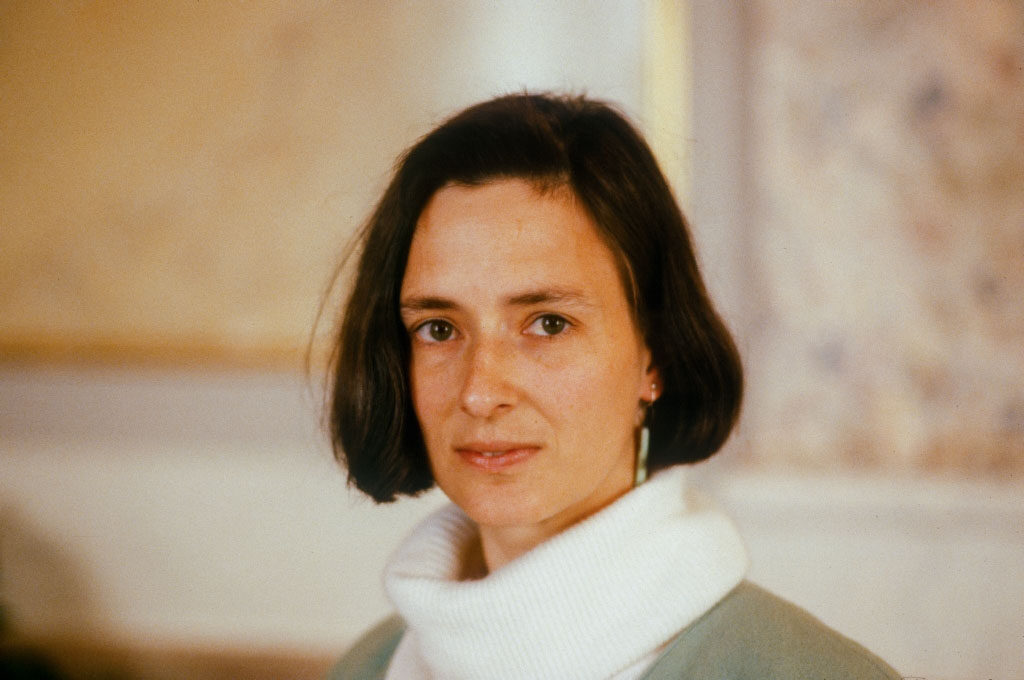Taking our seat at the table!
Women at ETH Zurich – from the early days to the present
For a long time there were few if any women at ETH. However, throughout its 150 year history, female trailblazers have repeatedly shattered the glass ceiling at ETH – with tenacity, knowledge and, occasionally, a bit of humour. They have achieved a great deal, but there is still much work to be done when it comes to providing equal opportunities for women.
“In our current age, in which, to a great extent, all human needs have been attended to, it is confounding that there should be no toilets with water closets for ladies in any of the buildings belonging to ETH.”
This statement was written by Anna Schinz-Mousson on 29 May 1918 and addressed to the rector of ETH Zurich at the time. As a “mother and a friend to young women”, she was writing to demand that the grievous lack of ladies toilets finally be remedied. After all, ETH, which had been founded nearly 70 years earlier, had expressly welcomed female students from day one. However, it was not actually properly equipped for the “ladies”: the ETH main building, which opened in 1864, was only built with men’s toilets, which were also solely used by male students and faculty.
Female trailblazers
It is hard for us to imagine today. In the meantime, we take it for granted that women study, research and teach at ETH. But it took a long time to get to this point: the first female student at ETH registered 16 years after the university was founded (in 1855), and 130 years passed before the first full female professor was appointed to a chair. And we still have a long way to go:
“It is the goal of university management to continually increase the numbers of female students and professors. In recent years, we have been able to make some progress in terms of hiring female professors. Since 2019, around 30 percent of our new hires have been women. But we understand that we still have a lot of work to do until both genders are represented equally across all levels of the hierarchy. When we take a look back, we see how far women have come at ETH and how far we still have to go.”
— Professor Dr Joël Mesot, President of ETH Zurich
Women have had to clear many hurdles: Initially, only wealthy families were able to afford a university education for their daughters and ensure that they were given the proper schooling to prepare them for university. After all, these young women were primarily educated at private schools. In Switzerland at the end of the nineteenth century, there were so few public schools for girls that most young women were unable to earn the secondary school degree that they would need to go on to university.
Accordingly, in these early days, most female students at Swiss universities came from other countries, and primarily from Russia (see graphic). 1

By 1906, these young women had increased the proportion of female students in Switzerland to one quarter of the total student body, but it would soon fall dramatically: with the start of the First World War in 1914 and the Russian Revolution in 1917, many foreign female students returned to their home countries.
Permitted to study, but not to work
The number of Swiss female students slowly grew. However, it was difficult for women to find employment after completing their studies. 3 For example, Baum, who received her degree as a specialist teacher for natural sciences at ETH in 1897, struggled with this issue. Eugen Bamberger, Professor of General Chemistry, wanted to hire her as a research assistant. But his request was denied:
“The University Council feels confident that the appointment of a female assistant would be rejected by the Federal Council and, without wanting to expressly declare itself as in opposition to such an appointment, would prefer to abstain from such an act provided that a suitable male candidate can be found.”
ETH was not the only institution to take such a firm stance: During this period, it was generally unacceptable in Swiss society for women to choose a “man’s profession”. A woman’s “natural” role was that of a housewife and a mother. A commonly held opinion at that time went so far as to declare that women did not have the mental capacity for university studies and the sciences. Despite all the societal resistance, there were a number of professors at ETH who advocated for women’s rights. One of them was geologist Albert Heim. 4 It is thanks to his efforts that Baum eventually was granted a position as a research assistant after initially being rejected. Heim himself also hired women, including Swiss geobotanist Marie Brockmann-Jerosch from 1902 to 1904. Brockmann-Jerosch was friends with Laura Hezner, who, in 1910, was the first woman to qualify as a senior lecturer at ETH in chemical mineralogy and petrography. She and the pharmacist Hedwig Delpy were also the first women to obtain doctoral degrees at ETH. 5
Traditional gender roles are hard to shake
Despite the success of individual women, it would take decades for women to truly take their place at the university. Female students rarely made up more than five percent of the student body at ETH until the late 1960s. Nevertheless, thanks to the efforts of women’s organisations, societal progress was made during this time in terms of education and gainful employment for women. This was demonstrated, for example, by the first Swiss Exhibition for Women’s Work (SAFFA), which was held in 1928 and was intended to illustrate women’s contributions to and important role within the national economy and society. The head architect was Lux Guyer, 9 who was the first woman to open her own architectural firm in Zurich and who completed part of her studies at ETH. However, it would take a long time for traditional gender roles to be critically examined. Even the second SAFFA, which was held in 1958, continued to promote these ideas. Most women continued to pursue traditional “women’s careers”. For this reason, there were very few women at ETH in particular, given its focus on natural sciences and mathematics. 10
A period of cultural transformation – Katharina von Salis
But then something changed: In the early 1970s, slowly but steadily, the number of female students at ETH began to increase. Growing numbers of female researchers also came to the university, including the geologist von Salis, who researched and taught at ETH from 1974 to 2001. “It was a period of cultural transformation,” recollects von Salis, who is now 79 years old. Switzerland granted women the right to vote in 1971. Prior to that, the new, autonomous women’s movement had emerged, women were vocally demanding equal rights and increasingly finding their place outside of the home. This also had a notable impact at ETH: For example, in 1976, the Association of students at ETH (VSETH) elected its first female president – Barbara Haering, who would go on to become a National Councillor. In 1979, the geobotanist Krystyna Urbańska was the first woman to acquire the title of honorary professor. And, in 1985, the architect Flora Ruchat-Roncati was the first woman to acquire a full professorship at ETH. A garden on the ETH Hönggerberg Campus is named after Flora Ruchat-Roncati.
Katharina von Salis made great strides in advancing equal opportunities at the university. Her efforts included organising ETH’s involvement in the Switzerland-wide women’s strike in 1991 and establishing the “Women’s Access Point”, which is now the Equal! Office of Equal Opportunities & Diversity. She was co-founder and president of the Conference for Women’s Rights and Equal Opportunities Officers at Swiss Universities and Institutions of Higher Education (KOFRAH), which was founded in 1992, and presided over the steering committee of the Swiss Federal Equal Opportunity at Universities Programme from 2000 to 2007. From an early age, she felt it was unfair that she was treated differently just because she was a girl: while the boys were allowed to play football outside, she had to sit inside and work on handicrafts. At baccalaureate school in Bern, where von Salis completed her federal academic baccalaureate in mathematics and natural sciences in 1959, she was sometimes the only young woman in her class. For this reason, she was forced to learn how to assert herself in a male-dominated environment. One of von Salis’ role models was her grandmother, a painter, who often said: “Modesty may be a virtue, but one goes further without it.” With this in mind, von Salis forged her own path, even when she was continually confronted with stumbling blocks. After completing secondary school, she studied geology at the University of Bern, where she earned her doctorate in 1965. Unlike her male colleagues, she was not allowed to participate in an expedition to Greenland: “At that time, women were simply not included.” Her career also got off to a rocky start: When she tried to apply for a job with Shell, she was told that they did not hire female geologists, only male geologists. Instead, von Salis chose to go into research. In 1965, she married a Danish man and moved with him to Copenhagen, where she was hired by the Geological Institute of the University of Copenhagen, later going on to become director of the institute. When her husband was transferred to Vienna in 1974, she took on a position as a research assistant at the Geological Institute of ETH. 11 In this role, she researched and taught micropaleontology, organised international congresses, wrote textbooks and founded the International Nannoplankton Association (INA). Her three daughters lived wherever her husband was working at the time: Vienna, The Hague, London. Von Salis commuted between her family’s current place of residence and her work in Zurich, spending a week at a time in each location. “ETH offered me the necessary flexibility to do this,” she says. She never considered giving up her career. Her mother 12 and grandmother, who were both independent and had earned their own incomes, had shown her that it was possible. In 1989, the whole family moved to Zurich, which made things much easier.
A key moment for equality
During this period, calls in Switzerland to actually implement measures for gender equality, which had been guaranteed in the Swiss constitution since 1981, were growing louder. 13 After all, women were still being paid less than men for the same job. Given the fact that companies and universities were oriented to the day-to-day lives of men, female student organisations and women’s organisations demanded, among other things, the introduction of women’s topics both in research and teaching. In 1987, female students and researchers at ETH founded the Association of Female ETHZ Students, Assistants, Lecturers and Alumni (VESADA), which campaigned for greater support and stronger networks for women. The key moment for von Salis’ in terms of gender equality came in 1990 at a department conference that was, in part, about changing the programme regulations for students. The conference took place on the day when Appenzell Innerrhoden became the last canton to grant women the right to vote. In honour of this occasion, von Salis suggested writing the new regulations using only feminine pronouns and adding a footnote stating that men are also intended to be included in these statements, the inverse of a common practice in German-speaking countries. A suggestion that was meant to be at once provocative and humorous resulted in strong reactions amongst her colleagues: “From that moment on, I was known only as the ‘women’s libber’ in the department.” 14 Von Salis saw her newly earned reputation as an opportunity to push harder than ever for women’s rights. Her next opportunity to do so was provided to her by the newly elected ETH President Jakob Nüesch, who stated in a newspaper interview that he was willing to do more for women at ETH. Von Salis met with him and received his approval to found a “Women’s Access Point”. 15 She herself took on 20 percent of the advisory workload. In the same year, 1991, half a million Swiss women went on strike.
Von Salis and other women organised activities at ETH, including a women’s sit-in in the faculty restaurant under the slogan “Taking our seat at the table!”. “The feeling in the room was amazing,” says von Salis. The resolution written by the women of ETH was read aloud at the Polyterrasse and then handed over to the university president with 1,400 signatures. The demands outlined in the resolution included better childcare, more part-time positions for both women and men, support for women across all levels, and help re-entering the workplace after taking maternal leave. These and many other measures were subsequently introduced. 16 In the Gender Action Plan, which was adopted in 2014, ETH demonstrated how it is actively supporting gender equality and how it wants to further the cause in the future.
Women at ETH today
The efforts to promote equal opportunities have been and continue to be successful: For example, the number of female professors at the university has increased since the 1990s. 17 Currently this amounts to 73 full-time equivalents. In 2007, the first woman was elected to university management, the highest level at ETH: the biologist Heidi Wunderli-Allenspach, who was ETH Rector and deputy to the ETH President until 2012. Sarah Springman, Full Professor of Geotechnology, has held this office since 2015. She has done a great deal to support female scientists and has made it her goal to get young girls excited about engineering.
On average, women make up one third of the undergraduate and doctoral students at ETH. This was the result of the most recent Gender Monitoring report, which ETH has compiled every year since 2009 to monitor the gender equality situation at the university. The numbers show, however, that many women continue to “get lost” along the way to higher-level careers in academia. 18 Ulrike Lohmann, Professor of Cloud Physics in the Department of Environmental System Sciences, has also observed this phenomenon: “Very few of my female doctoral students, even extremely talented ones, do remain in the sciences after completing their doctoral thesis.” One common reason is that these young women want to start a family and are afraid that the two are incompatible. For this reason, ETH is making a concerted effort to facilitate family and work life. 19 ETH is also making an effort to attract more excellent female professors to the university. For this reason, rules have been introduced for search committees, including a rule that states that at least two female candidates must be invited for interviews. 20 Ulrike Lohmann, who has been a delegate of the ETH president for heading search committees, feels certain: these kinds of measures are helpful and effective when it comes to achieving a better gender equality balance.
However, this also requires committee members to overcome the gender stereotypes that often remain lodged in our minds:
“There are still very few women in natural science and technical disciplines, even at ETH Zurich. When it comes to electrical engineering, computer science and mechanical engineering, women are just as capable as men. Moreover, we now understand how important it is for men and women to work together to find solutions in order for a project to be successful. As a rule, different perspectives lead to better results. However, we are often confronted with gender stereotypes that say that women are not as well-suited for math, physics or technology. The Equal! Office of Equal Opportunities offers a number of workshops and courses that are intended to help us overcome these stereotypes.”
— Renate Schubert, delegate of the ETH President for equal opportunities and Head of the Equal! office
From the beginning, ETH made a serious effort to welcome men and women equally. Regarding the lack of toilets mentioned earlier, the letter writer – Anna Schinz-Mousson, the influential spouse of an honorary professor at the University of Zurich – was granted her request: The rector immediately forwarded her letter to the President of the University Council, who in turn forwarded the letter to Professor of Architecture Gustav Gull, who was redesigning the ETH main building that year in 1918. As a result, ladies toilets were constructed, and a fundamental shortcoming was remedied.
Footnotes
- In the second half of the nineteenth century, women were repeatedly prohibited from studying in Russia. As a result, many young women sidestepped these bans by studying in Switzerland, which was much more liberal. https://unigeschichte.unibas.ch/akteure/frauenstudium/anfaenge-des-frauenstudiums/anfaenge-des-frauenstudiums.html Many of these young Russian women were politically active and held socialist and emancipatory views, including the first female students at ETH Nadezda Smeckaja and Marie Kowalik. https://blogs.ethz.ch/digital-collections/2013/07/05/die-eth-eine-sozialrevolutionare-brutstatte-die-russischen-anfange-des-frauenstudiums ↩︎
- Even though she is listed under the name Nadina Smetzky in the student register (ETH Library, ETH Zurich University Archives, EZ-REK1/1/2712) and in the student directory of the Federal Polytechnic Institute Zurich, the name Nadezda Smeckaja is generally used in the relevant literature in connection with the first female student at ETH. https://blogs.ethz.ch/digital-collections/2009/08/20/studentendossiers-der-eth-zurich ↩︎
- The first Swiss female attorney, Emilie Kempin-Spyri, who studied at the University of Zurich and received her doctorate in 1887, fought in vain to be allowed to practice law. The ability to practice law was tied to active citizenship, which was only available to men at that time. Kempin-Spyri eventually decided to leave Switzerland and emigrate to the United States. ↩︎
- Albert Heim was married to Switzerland’s first female doctor, Marie Heim-Vögtlin. She studied medicine at the University of Zurich and also experienced difficulties at the start of her career: no Swiss hospital was willing to hire a woman, so she was forced to move to Germany to complete her residency. Eventually she returned to Switzerland and was the first woman to open her own medical practice there. https://www.uzh.ch/blog/hbz/2019/03/11/erste-medizinstudentinnen-an-der-universitaet-zuerich ↩︎
- ETH had only earned the right to issue doctorates in 1908. ↩︎
- As a researcher, Marie Brockmann-Jerosch published a number of important works about the emergence of Alpine flora after the most recent ice age. Her theories have since been proven by contemporary research results. https://www.researchgate.net/publication/226318318_Marie_Brockmann-Jerosch_and_her_influence_on_Alpine_phylogeography ↩︎
- Lux Guyer was a guest student at ETH Zurich, completed apprenticeships at architectural firms in Zurich and Berlin, and was the first architect to open her own firm in Switzerland in 1924. On behalf of women’s organisations, she designed apartments for single women, among other projects. ↩︎
- Thanks to its modular components, the prefabricated house took just three months to build. ↩︎
- Lux Guyer was the first person to build apartments for single women in Zurich, for example the Lettenhof housing estate (1926–1927) and the women’s student dormitory in Fluntern (1927–1928). https://hls-dhs-dss.ch/de/articles/009326/2006-03-10 ↩︎
- Only in a few subjects was their share relatively high; in pharmacy it was already around 50 percent in the 1950s. http://www.ethistory.ethz.ch/statistik/04Weibliche_Studierende.pdf ↩︎
- She would later become senior assistant and, in 1992, she would acquire the title of honorary professor. ↩︎
- Charlotte von Salis-Bay (1917–2016), Katharina von Salis’ mother, was a well-known journalist and fashion illustrator. ↩︎
- The Swiss Gender Equality Act, which put the constitutional obligation into concrete terms and serves as an important instrument for achieving true equality between men and women, did not go into effect until 1996. ↩︎
- Von Salis discussed this experience in an interview with Explora author Claudia Hoffmann. ↩︎
- Today, the “Women’s Access Point” is called the Equal! Office of Equal Opportunities. Read more about Equal! Office of Equal Opportunities: https://ethz.ch/services/de/anstellung-und-arbeit/arbeitsumfeld/chancengleichheit/portrait/geschichte.html ↩︎
- The first Equal Opportunity Officer was Silvia Wyler. Working together with von Salis in internal working groups, she created a comprehensive “Development Plan for 1996–1999”. ↩︎
- By the time that ETH President Jakob Nüesch retired in 1997, the number of women professors at ETH had grown from only two in 1991 to 12 full professor and associate professors, five honorary professors and eight assistant professors. https://ethz.ch/services/de/anstellung-und-arbeit/arbeitsumfeld/chancengleichheit/strategie-und-zahlen/frauen-an-der-eth/geschichte-der-frauen-an-der-eth/von-der-ersten-studentin-bis-zu-den-heutigen-forscherinnen0.html ↩︎
- Women currently account for just 15 percent of senior scientist and professor positions. ETH Domain institutions are working to change this through the “Fix the leaky pipeline” programme. This programme provides young researchers with mentoring programmes and training to help them develop a strategy for their careers and to help them expand their scientific networks. ↩︎
- This includes the expansion of the childcare programme by one third in 2018; now a total of eight day care centres (ETH and UZH), day nurseries and a nanny service are available to ETH staff and faculty. New parents can split their four-month parental leave between both parents as long as they both work at ETH. Moreover, ETH offers flexible working models such as part-time work and working from home. https://ethz.ch/services/de/anstellung-und-arbeit/arbeitsumfeld/chancengleichheit/strategie-und-zahlen/frauen-an-der-eth/frauenstreik-eth/frauenfoerderung.html ↩︎
- The search committee itself must also include at least two women. Furthermore, one member of the committee takes on the role of “Gender and Diversity Advocate” in order to ensure that the hiring process is fair. Moreover, the committee’s final recommendation – generally a list of three candidates – must include at least one woman (suitable justification must be submitted to the ETH President for an exception to be granted). ↩︎
